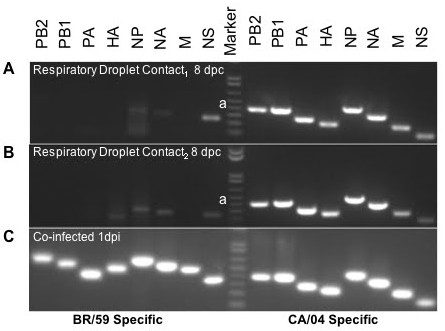

Ferrets were intranasally co-infected with an H1N1 pandemic strain [Ca/04] and either a seasonal H1N1 virus [BR/59] or a seasonal H3N2 virus [BR/10]. One uninfected ferret was placed in the same cage (to allow contact transmission) and a second in another cage separated by a wire mesh (to allow aerosol transmission). They determined whether the viruses replicated in the animals by detecting viral RNA in nasal washes taken 1 day after infection using polymerase chain reaction (PCR), or by hemagglutination-inhibition assays to measure serum antibodies.
The results are striking. Both viruses replicate well in co-infected ferrets – look at panel C of the image above. The figure is a photograph of the DNA products of the PCR, separated by gel electrophoresis. Each lane shows the DNA corresponding to the individual influenza viral RNA. Panels A and B show the amplified DNAs from the nasal washes of two animals who were infected by contact. In these animals, the pandemic CA/04 virus replicates well (right half) while the seasonal H1N1 strain [BR/59] does not (left half).
When the nasal washes from the respiratory droplet contact ferrets were used to infect a new set of ferrets, only the pandemic CA/04 virus was detected; there was no evidence of the seasonal BR/59 or BR/10 viruses.
The pattern of the DNAs are distinct for each virus. For example, the PB2 DNA of BR/59 migrates more slowly on the gel than the PB2 DNA of CA/04 (panel C). Given these differences in migration of the DNAs, it would be easy to determine if there were reassortants in the co-infected ferrets. None can be detected by this analysis.
If these results were directly applicable to humans, we would predict that the 2009 H1N1 pandemic strain is not likely to reassort with the seasonal strains; and that it will out-compete those strains, which will eventually disappear. But we are not ferrets, and we don’t know whether these findings apply to humans. Nevertheless, the authors are allowed to speculate:
Although we must be cautious interpreting studies in the ferret model, it is reasonable to speculate that this prototypical pandemic strain, Ca/04, has all the makings of a virus fully adapted to humans.
In this case ‘fully adapted’ means that the pandemic strain replicates better than the seasonal strains or any reassortants that might arise in co-infections.
What did the press learn from this work? Reuters concluded:
And while a new study in ferrets suggested the virus spreads more quickly and causes more severe disease than seasonal flu, the good news is that it does not appear likely to mutate into a “superbug” as some researchers had feared.
Virologists consider mutation and reassortment to be two distinct phenomena. The mutation rate of the virus is determined by error-prone RNA synthesis. The host applies the selection pressure that enriches for a particular phenotype. The results of these studies reveal nothing about the ability of the virus to mutate.
Perez, D., Sorrell, E., Angel, M., Ye, J., Hickman, D., Pena, L., Ramirez-Nieto, G,, Kimble, B., & Araya, Y. (2009). Fitness of Pandemic H1N1 and Seasonal influenza A viruses during Co-infection PLoS Currents RRN1011.2.

Pingback: Pandemic H1N1 influenza virus outcompetes seasonal strains in ferrets « Swine Flu
Pingback: Pandemic H1N1 influenza virus outcompetes seasonal strains in ferrets | Swine Flu Outbreak
You wrote, “…we would predict that the 2009 H1N1 pandemic strain is not likely to reassort with the seasonal strains; and that it is likely to out-compete those strains and eventually disappear.” So, are you saying that since the pandemic H1N1 does not appear to be able to reassort with seasonal flu that it is unlikely to become seasonal and may therefore disappear? And, why would pandemic H1N1 need to be part of a reassorting “event” to become a seasonal problem?
My apologies for a poorly worded sentence. I meant to hypothesize that
the pandemic strain would not reassort with seasonal strains, and in
out-competing them, would drive them from the human population. I have
fixed the sentence in the original post. I hope it is now clear that
reassortment would not be necessary for the pandemic strain to become
a seasonal one; this is absolutely not the case.
perfectly clear now…Thanks!
How is the pandemic H1N1 able to out-compete the seasonal strains and become the only strain to be found in nasal washes from the co-infected ferrets? What is it about this pandemic virus that gives it such a competitive advantage?
Pingback: Influenza virus reassortment, then and now
Good question, no one has an answer yet. I am sure someone is making
reassortants between the pandemic H1N1 strain and seasonal strains to
see which RNA segment(s) confer that property.
fea
my question is regarding this statement you mentioned above as “The pattern of the DNAs are distinct for each virus. For example, the PB2 DNA of BR/59 migrates more slowly on the gel than the PB2 DNA of CA/04 (panel C). Given these differences in migration of the DNAs, it would be easy to determine if there were reassortants in the co-infected ferrets. None can be detected by this analysis”.
Q. How can you say there are no reassortments given the fact that there are differences in the pattern migration of seasonal and pandemic stains. reassortants are detected by differences in the migration right before sequencing them??